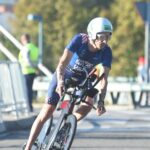Focus is the most misunderstood mental factor among athletes. Most athletes think of focus as concentrating on one thing for a long time. In fact, a number of years ago, former Australian Open tennis champion Hana Mandlikova said that she improved her game by staring at a tennis ball for ten minutes a day. She may have believed that, but, given the complexity of tennis and most other sports, it probably didn’t help much.
Let me introduce a term and then I’ll define focus for you. Attentional field is everything inside of you, such as thoughts, emotions, and physical responses, and everything outside of you, including sights and sounds, on which you could focus. Focus is the ability to attend to internal and external cues in your attentional field.
Prime focus involves focusing only on performance-relevant cues in your attentional field. In other words, only focusing on cues that help you to perform your best. Depending on the sport, performance-relevant cues can include technique, tactics, your opponent, the score, time remaining, and many other cues. Prime focus gives you the ability to adjust your focus internally and externally as needed during the course of a competition.
For example, a football quarterback first focuses internally to select the best play based on the current game situation. As the huddle breaks and he moves over center, he widens his focus externally to survey the defensive alignment. When the ball is hiked and he drops back to pass, the quarterback focuses on the routes of his receivers until he finds one who is open, at which time he narrows his focus onto that receiver and throws him the football.
Poor focus, in contrast, involves focusing on performance-irrelevant cues in your attentional field. That is, focusing on cues that will hurt your performance. There are two types of harmful cues. Interfering cues are those that will directly hurt your performance such as negative thoughts, anxiety, and concern over who your next opponent will be if you win. Irrelevant cues are those that simply distract you from an effective focus including what you’ll have for dinner tonight or the project that you must finish by tomorrow.
Focus Style
One of the most important developments I’ve made in my work in recent years is in understanding the importance of identifying athletes’ focus styles. A focus style is a preference for paying attention to certain cues. Athletes tend to be more comfortable focusing on some cues and avoid or don’t pay attention to other cues. Every athlete has a dominant style that impacts all aspects of their sports performance. This dominant style will surface most noticeably when they’re under pressure. The two types of focus styles are internal and external.
Internal focus style. Athletes with an internal focus style perform best when they’re totally and consistently focused on their sport during a practice session or a competition. They need to keep their focus narrow, thinking only about their sport. These athletes tend to be easily distracted by activity in their immediate surroundings. If they broaden their focus and take their mind off their sport, for example, if they talk about non-sport topics with their coach during a practice, they’ll become distracted and will have trouble narrowing their focus back onto their sport.
External focus style. Athletes with an external focus style perform best when they only focus on their sport when they’re about to begin a drill in practice or begin a competition. At all other times, it is best for them to broaden their focus and take their mind off their sport. These athletes have a tendency to think too much, become negative and critical, and experience competitive anxiety. For these athletes, it’s essential that they take their focus away from their sport when they’re not actually performing.
External focus style runs counter to beliefs held by many coaches. They think that if athletes are not totally focused on their sport, then they’re not serious about it and they won’t perform their best. Yet, for athletes with an external focus style, they don’t want to think too much or be too serious because this causes them to lose confidence and become anxiousl. They’ll perform their best when they’re not thinking too much about their sport and they simply allow their natural abilities to emerge on their own.
Identifying Your Focus Style
With this understanding, you need to identify what is your focus style. Are you an athlete who needs to keep your mind on your sport constantly in order for you to perform well? Or are you someone who thinks too much and needs to keep your mind off your sport until its time to perform?
Recall past competitions and practices when you’ve performed well. Were you totally focused on your sport or were you keeping your mind off your sport? Also, recall past competitions and practices when you’ve performed poorly. Were you thinking too much or were you distracted by things going on around you? If you’re like most athletes, a pattern will emerge in which you tend to perform best when you focus one way and you perform poorly when you focus another way.
Understanding your focus style is essential for you to be able to manage it effectively. This process involves knowing how you focus best and actively focusing in a way that is consistent with your focus style. This ability to manage your focus style well is most important in pressure competitive situations. There is a tendency for athletes under pressure to revert back to a focus style that will interfere rather than help their performance. For example, if you’re someone who performs best with an external focus style, you may find yourself turning your focus inward when the pressure is on. You may start to think too much and become anxious.
When you start to lose your prime focus style under pressure, you must become aware that you’re moving away from it and that you need to take steps to redirect your focus back to the style that works best for you. Continuing the previous example, when you realize that you’re focusing internally too much, you should actively turn your focus outward by looking around and taking your mind off your sport.
Mag-Lite® Focus
I’ve developed a useful tool to help you understand your focus style and to develop focus control. A Mag-Lite® is a flashlight whose beam can be adjusted to illuminate a wide area or to brighten a narrow area. Your focus can be thought of as a Mag-Lite® beam you project that illuminates on what you want to focus.
Athletes with an internal focus style want to keep their Mag-Lite® beam narrow at all times, only illuminating sport-related things during practice or competitions. If you have an internal focus style, your goal is to stay focused on necessary training or competitive cues and to block out unnecessary external distractions. To accomplish this, narrow your Mag-Lite® beam by keeping your eyes within the confines of the practice or competitive setting and avoid talking to others. Focus on important sport cues, for example, the proper technique for the next drill or your intensity for the next performance.
Athletes with an external focus style want to widen their Mag-Lite® beam between drills and performances to take their mind off their sport, then narrow their beam shortly before they begin the next drill or performance. If you have an external focus style, your goal is to direct your focus off of your sport between drills in practice and between performances in competitions. To do this, when you’re not actually performing, whether in practice or competition, widen your Mag-Lite® beam by looking around you and talking to your coach or other athletes. This will keep you from thinking too much and becoming anxious. Shortly before you begin the next drill in practice or next performance in a competition, narrow your Mag-Lite® beam, focusing specifically on something that will help you perform well.





